Hello students! Are you looking for reliable solutions to Poorvi Unit 2 Friendship Chapter 4 ‘The Unlikely Best Friends’?
Here we’ve provided excellent solutions which will address all your queries about this chapter. We recommend you go through them in detail – they should clear all your doubts and help you understand the story. We have taken care to provide lucid and well-written answers to all the end-text questions as well as all the activities so that you can just relax and study to ace your exams!
Find Solutions to NCERT Class 6 English Poorvi Unit 2 Friendship Chapter 4 ‘The Unlikely Best Friends’ here.
Let us do these activities before we read.
1. Friends are an important part of our lives. Why do you think so? Share your ideas with your friend. What do you do when you are with your friends and how do you feel?
Answer:
Friends are important to me because they offer support, companionship, and are fun. They are always there to listen when I need someone to talk to, and share my joys and difficulties. Friends help me grow as a person and tell me when I am wrong so that I can improve. I share secrets with my friends.
I enjoy playing badminton and table tennis with my friends. We also like to go to the movies, play video games, and spend time in each other’s houses. Sometimes, we try to cook or bake together and enjoy tasting the dishes we make. We also enjoy studying together and helping each other with homework.
My friends make me feel happy and valued. They boost my confidence and encourage me when I am feeling down. When I am with my friends, I feel relaxed and comfortable because I can be myself without any fear of judgment. They bring a lot of joy and laughter into my life.
Now, complete the following sentences by writing in the shapes given below. Share your completed sentences with your classmates and teacher. One has been done for you.
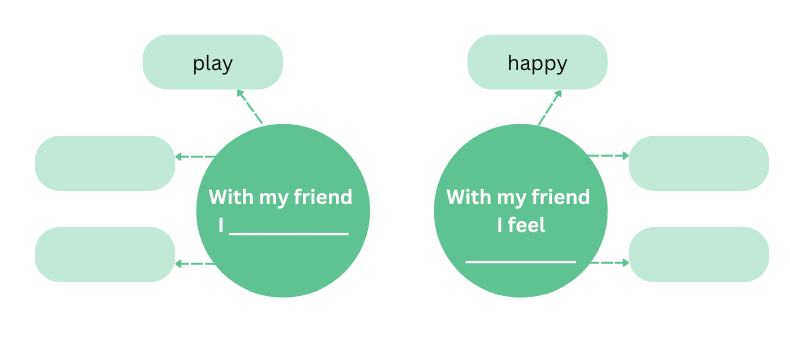
Answer:
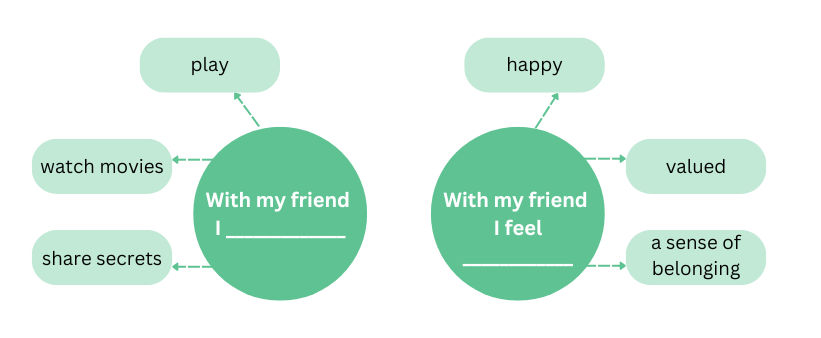
2. The title of the chapter is ‘The Unlikely Best Friends’.
(a) What can be the meaning of ‘unlikely’? Discuss in groups, and then discuss with your teacher.
Answer:
‘Unlikely’ refers to something unusual or surprising. It is something that one does not expect to happen just like the unusual friendship between the elephant and the dog in the story.
Although they belong to different species altogether, their loneliness draws them together and they long for each other’s company.
(b) Can you think of some unlikely friends? Share your answer with your teacher.
Answer:
(i) In the story of “Elsa the Lioness,” we read about Joy and George Adamson raising an orphaned lion cub in Kenya. Despite being a wild animal, Elsa forms a close bond with the Adamsons. This unlikely friendship is described in the book and movie “Born Free,” showing the deep connection between humans and animals.
(ii) Theoretical physicist Stephen Hawking and comedian Jim Carrey shared an unexpected friendship. Carrey admired Hawking’s intellect and courage, and they met on several occasions, including a memorable encounter at a science event. Their friendship highlighted the bridging of the worlds of science and entertainment.
(iii) Mother Teresa and Princess Diana:
Mother Teresa, a Catholic nun who dedicated her life to serving the poor in Kolkata, India, and Princess Diana, a member of the British royal family, shared a deep bond. Despite their vastly different economic status, they connected over their mutual dedication to humanitarian causes. Their friendship was publicly evident when they met several times to support each other’s charitable endeavours.
Text Book Page no 42
Let us discuss
1. Talk about the things that Gajaraj and Buntee did together. Now, write in the shapes given below. One has been done for you.
Buntee and Gajaraj _____________? Played
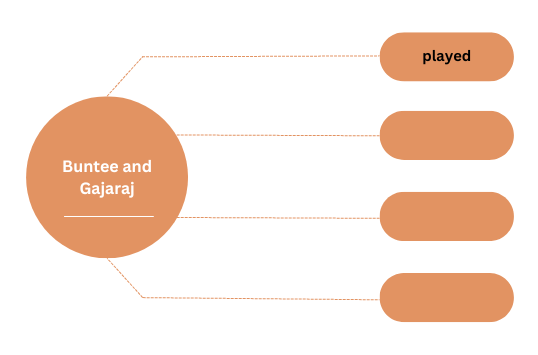
Answer:
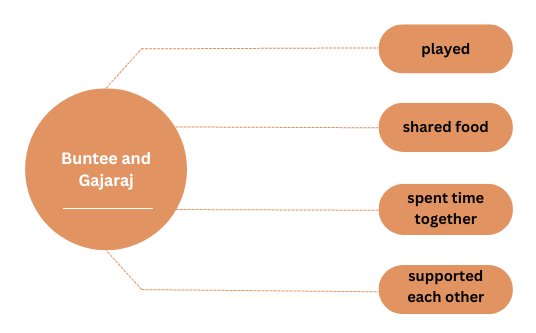
2. Why did the farmer hug Buntee?
Answer:
The farmer hugged Buntee because he was overjoyed to find his lost dog. The farmer had been searching for Buntee ever since the dog disappeared. So, he hugged him affectionately relieved to be reunited with his missing pet.
3. Do you think Buntee will leave Gajaraj and go home with the farmer?
Answer:
I think that Buntee will not leave Gajaraj to go home with the farmer. Although Buntee has a home with the farmer, he has developed a strong bond with Gajaraj. The emotional connection and companionship he shares with Gajaraj will make it difficult for him to part ways. He might feel torn between his new friend and his previous owner.
Text Book Page no 45
Let us discuss
1. Why did Gajaraj not eat his food?
Answer:
Gajaraj did not eat his food because he was missing his friend, Buntee. After Buntee was taken away by the farmer, Gajaraj felt sad and lonely, which affected his appetite. His distress over the loss of his friend caused him to refuse his food, as he felt too depressed to enjoy his meals.
2. Who were friends at the end of the story?
Answer:
At the end of the story, the two friends, Gajaraj and Buntee, were joyfully reunited. The farmer and the mahout, who watched this reunion, also became friends. Their shared happiness over the animals’ bond led to mutual respect and a new friendship.
Let us think and reflect (Page 45)
1. Read the following lines and answer the questions that follow.
(a) In spite of royal comforts, Gajaraj was sad because he had no friends. The mahout, or elephant trainer, was the only one he ever interacted with. The mahout was a kind man who served Gajaraj food, and gave him a bath in the elephant pond daily. He was a good caretaker, but not a friend.
(i) Complete with one word:
mahout : kind : : Gajaraj : __________
Answer:
mahout : kind : : Gajaraj : lonely
ii) The mahout was a good caretaker because he gave ________to Gajaraj and a ______in the pond.
Answer:
The mahout was a good caretaker because he gave food to Gajaraj and a bath in the pond.
(iii) What do you think is the difference between a friend and a caretaker?
Answer:
A friend provides companionship and emotional support, whereas a caretaker focuses on practical needs, such as providing care and managing daily tasks. A friend shares mutual feelings and interests, while a caretaker performs responsibilities without necessarily forming a close personal bond.
(b) “Are you missing your friend?” asked the farmer remembering the happy look on Buntee’s face while sitting on the elephant’s back. “I cannot see you go hungry,” said the farmer, “If you miss your friend so much, go to him.” The farmer removed the rope with which he had tied the dog.
(i) The farmer uses the word __________________ to refer to the elephant.
Answer:
The farmer uses the word friend to refer to the elephant.
(ii) How did the farmer know that Buntee was hungry?
Answer:
The farmer knew that Buntee was hungry because Buntee had not touched his food since he was brought home.
(iii) Why did the farmer remove the rope with which he had tied Buntee?
Answer:
The farmer removed the rope with which he had tied Buntee because he realized that Buntee was pining for his friend Gajaraj. The kind farmer wanted to free Buntee so that he could return to the stable and reunite with Gajaraj. The farmer knew that this would make both animals happy.
(iv) Complete with one word:
Gajaraj : Buntee : : __________ : farmer
Answer:
Gajaraj : Buntee : : mahout : farmer
2. Give two examples to show that Gajaraj was very happy to have a friend.
Answer:
The following examples show that Gajaraj was very happy to have a friend:
Gajaraj playfully splashed water on Buntee while bathing, showing joy and a desire to have fun with his new friend.
Gajaraj gently picked up Buntee with his trunk and gave him a ride on his back, indicating his happiness and affection for Buntee.
3. How did the mahout come to know that Gajaraj was sad?
Answer:
The mahout noticed that Gajaraj was not eating his food, which was very unusual for him. Gajaraj’s refusal to eat for two days made the mahout realize that something was wrong, and he suspected that Gajaraj was missing Buntee.
4. Why do you think Buntee licked the farmer’s hand?
Answer:
I think that Buntee licked the farmer’s hand out of affection and gratitude towards his owner who set him free to reunite with his friend, Gajaraj.
5. What was ‘unlikely’ about the friendship of Gajaraj and Buntee?
Answer:
The friendship between Gajaraj and Buntee was ‘unlikely’ because they belonged to two different species—an elephant and a dog. Despite the differences in their size, behaviour, and needs, they developed a close bond, which is unusual and unexpected in the natural world.
Text Book Page no 46
Let us learn
1. Gajaraj was sad without a friend and when he met Buntee, he was filled with joy. ‘Sad’ and ‘filled with joy’ are opposites. Opposites can also be formed by adding some letters before a word. For example, un- unhappy, in- incorrect, dis- disconnect, mis- misuse. Now, take help from the words given as hints and fill up their opposites in the puzzle. (Note: All the words are from the story you have just read.)
We are opposites!

Across:
3. unkind
7. yelped
8. awake
9. relieved
10. missing
Down:
1. started
2. appeared
4. sad
5. untouched
6. hate
Answer:
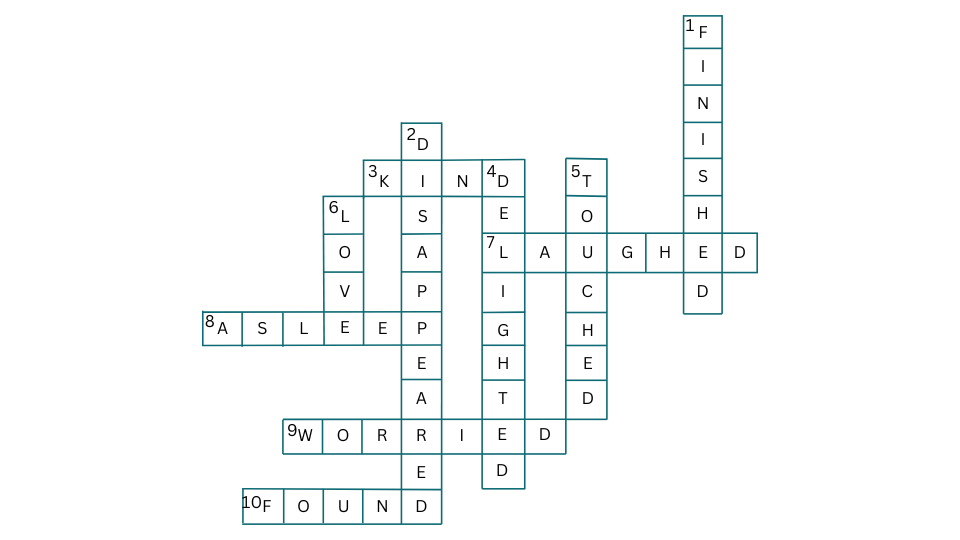
2. Now, complete the paragraph with some of the words you have used in the puzzle.
My pencil was _____________. I was very ________________ as it was a gift from my friend. I woke up my elder brother who was ____________ on the bed. I told him that my pencil seemed to have ________________. He _______________ and told me to look under my pillow. I was ___________________ when I ______________ the pencil there.
Answer:
My pencil was missing. I was very sad as it was a gift from my friend. I woke up my elder brother who was asleep on the bed. I told him that my pencil seemed to have disappeared. He laughed and told me to look under my pillow. I was delighted when I found the pencil there.
3. The words that tell us about an action are called verbs. In the story, the author tells us what happened before. To do that, the past form of the action word (verb) is used. Let us learn about the three forms of past tense.
| Simple Past Tense | Past Progressive Tense | Past Perfect Tense |
| Used to show that the action had happened earlier. • second form of the verb + add -d or -ed to the verb | Used to show that the action did not finish and was going on. • I/He/She/It + was + verb + ing • We/You/They + were + verb + ing | Used to show that the action was completed. • had + third form of the verb |
Given below are some verbs from the story. Put the verbs in their correct column in the table given above.
• was looking looked gave had ordered
• was missing hated had followed noticed
• was munching went had remained served
• told asked felt touched
• had tied joined arrived threw
Answer:
| Simple Past Tense | Past Progressive Tense | Past Perfect Tense |
| Used to show that the action had happened earlier. • second form of the verb + add -d or -ed to the verb | Used to show that the action did not finish and was going on. • I/He/She/It + was + verb + ing • We/You/They + were + verb + ing | Used to show that the action was completed. • had + third form of the verb |
| told | was looking | had tied |
| looked | was missing | had followed |
| hated | was munching | had remained |
| went | had ordered | |
| joined | ||
| gave | ||
| felt | ||
| arrived | ||
| noticed | ||
| served | ||
| touched | ||
| threw |
Select the correct form of the verb to complete the passage. Check your answers with the teacher.
The farmer came back and ____________ (noticed/was noticing/had noticed) that Buntee was sad. He ____________ (tied/ was tying/had tied) Buntee with a rope the day before. He ____________ (asked/was asking/had asked) Buntee why he was sad. Farmer ____________ (felt/was feeling/had felt) that Buntee ____________ (missed/was missing/had missed) Gajaraj and set him free.
Answer:
The farmer came back and noticed (noticed/was noticing/had noticed) that Buntee was sad. He had tied (tied/ was tying/had tied) Buntee with a rope the day before. He asked (asked/was asking/had asked) Buntee why he was sad. Farmer felt(felt/was feeling/had felt) that Buntee was missing (missed/was missing/had missed) Gajaraj and set him free.
4. ‘…neither the farmer nor the mahout noticed that the two friends were in tears.’
The words ‘neither’, ‘nor’ are used to state that the farmer and the mahout did not notice the same thing. ‘Neither, nor’ connect two negative choices. For example: Neither Rohit nor I want to play football.
When you need to choose between two things that you want, you may use ‘either, or’. For example: Rohit wants to play either cricket or kho-kho.
It means Rohit wants to play cricket or Rohit wants to play kho-kho.
Discuss the given sentences with your teacher to practice.
• Neither Shikha nor Anuj like to tell stories.
• Either Bhavesh or Abha made this painting.
Answer:
Sentence 1. Neither Shikha nor Anuj likes to tell stories.
The sentence means that both Shikha and Anuj do not like to tell stories.
“Neither” and “nor” are used to connect two negative choices, indicating that neither of the two subjects (Shikha and Anuj) likes storytelling.
Example usage: Neither my friends nor my siblings want to be my video gaming partner.
Sentence 2. Either Bhavesh or Abha made this painting.
The sentence means that only one of the two people, Bhavesh or Abha, made the painting.
“Either” and “or” are used to present two possibilities, indicating that it must be one or the other, but not both.
Example usage: Either Ram or Rani will lead the choir.
These conjunctions help clearly specify whether we are discussing two negative options or two positive choices. They are useful for making our statements precise and avoiding ambiguity.
Text Book Page no 49
Let us listen
1. You will listen to a story about ‘Unlikely Friends’. Use exact words from the story to fill up the missing details in the paragraph. (refer to page 71 for transcript)
The leopard is a wild animal but it became a friend of a cow. When the leopar grew up, it left the village. It came in the night to meet the cow. The leopar would sit beside the cow. They also played together. The villagers were surprised at their friendship.
2. Now, listen to the story again and number the sentences in correct order.
The first one has been done for you.
The leopard stopped coming regularly.
1. The cow took care of the leopard cub as a mother.
The leopard came to meet the cow at night.
The leopard left the village after growing up.
Answer:
4. The leopard stopped coming regularly.
1. The cow took care of the leopard cub as a mother.
3. The leopard came to meet the cow at night.
2. The leopard left the village after growing up.
Let us speak
Gajaraj and Buntee had a wonderful time with each other even if they were ‘unlikely’ friends. Talk to your friend and find out your common likes and dislikes. Share your answers with the class.
I am Rani
I like:
• Baking
• Reading
My friend is Rita
My friend likes:
• Eating
• sports
Both of us like:
• going for walks
• trying out street food
Now, tell your classmates about your friend. You may take help of the cues given below.
• My friend and I like to play. Both of us want ___________.
• I like to ___________ but my friend likes to ___________.
• We are different as she/he is ___________ and I am ___________.
Answer:
• My friend and I like to play. Both of us want to win.
• I like to read but my friend likes to play sports.
• We are different as she is outgoing and I am an introvert.
Let us write (page 51)
Write six sentences about your friend with the help of the facts collected in the above task. Mention how you are not only similar but also different. You may take help of the words given
| same | different | and | but | both |
| still | like | unlike | neither…nor | either…or |
My friend and I both enjoy spending time together, but we have different interests.
I like to read, whereas my friend likes to play sports.
Unlike me, my friend is outgoing, while I am reserved.
Neither she nor Ilike to be bored, so we find activities that we both enjoy. Either we play games together or we find tasty street food to try out, and this keeps our friendship strong. We have our differences, but we still enjoy spending time together.
Text Book Page no 51
Let us explore
1. The story, ‘The Elephant and the Dog’ is found in the Jataka tales. These stories are ancient Buddhist stories of life values and wisdom. These stories have been told from one generation to the next for over two thousand years. Find and read another Jataka story.
Answer:
Here is another Jataka Tale:
The Golden Goose
Once upon a time, in a lush forest near a serene lake, there lived a golden goose. This goose was not only remarkable for its golden feathers but also for its kindness and wisdom. The goose had three daughters, and together they lived a peaceful life.
One day, the golden goose overheard some villagers lamenting about the hardships they were facing due to a poor harvest. They had no means to buy food and were in dire need of help. Feeling sorry for the villagers, the golden goose wanted to help them.
The next morning, the golden goose flew to the village and spoke to the headman. The headman was stunned to see a bird with shimmering feathers of gold. The goose told him, “I want to help your people. Each week I will give you one of my golden feathers. You may sell the feather and use the money to support the villagers.”
The headman readily accepted to the goose’s offer. As promised, the golden goose gave one of her golden feathers to the headman every week. The villagers sold the feathers and used the money to, build new homes, buy food, and create a thriving community.
However, the headman soon became greedy. He thought that instead of waiting for the goose to give him one feather per week, he could get rich instantly if he plucked all the feathers at once.
So, on the golden goose’s next visit, the covetous headman caught her and cruelly plucked all her golden feathers. But to his horror, the feathers turned white and lost their value. The golden goose who was in great pain told the headman, “Your greed has brought this upon you. My feathers were meant to be given freely, not taken by force.”
The headman realized his mistake, but it was too late. The golden goose flew away, never to return. Without the steady flow of golden feathers, the villager soon fell back into hardship.
Moral of the story: The tale teaches the value of patience and kindness and the dangers of greed. True wealth and prosperity come from generosity and kindness, not from selfishness and greed.
2. Elephants have historically held significant roles in Indian culture, spanning history, warfare, religion, festivals and more. However, contemporary ecological challenges have strained the relationship between humans and elephants. Have a discussion in the class.
Answer:
Discussion
Teacher: Of late we have been hearing of incidents where elephants enter villages, destroy the crops and of retaliation by villagers. Today, we’re going to have a discussion on how we can help elephants live peacefully and safely alongside humans. Let’s discuss about some important measures that can make a difference. Who wants to start?
Rani: I think one of the first steps is to protect the habitats of elephants. We need to make sure that forests are not cut down, and we should also work on replanting trees in deforested areas.
Kunal: Yes, protecting forests is crucial! But it’s also important to create wildlife corridors. These are special paths that connect different forest areas, allowing elephants to travel safely from one forest to another without coming into contact with human settlements.
Teacher: Yes, Rani and Kunal, you have both mentioned important points. What about the others? Everyone must participate in the discussion.
Rama: Another way to prevent confrontation between elephants and human beings is by using electric fences around farms and villages. This can keep elephants away from crops and prevent them from entering areas where they might cause damage.
Puneet: That’s a valid point! We should also have early warning systems that alert villagers when elephants are nearby. This way, they can be prepared and take steps to avoid any problems.
Sunita: We need to teach local communities about the importance of elephants and how they can live peacefully with them. Besides, the government should compensate the farmers for any loss of crop which are destroyed by elephants. This step would help reduce anger and promote tolerance towards elephants.
Rani: I agree! We should also focus on conservation efforts like strengthening anti-poaching laws. Elephants are often targeted by poachers, so strict laws are needed to protect them.
Ravi: Another good move would be to increase the number wildlife sanctuaries and national parks. If we create more safe places where elephants can live without fear, it will help them thrive.
Kunal: We should promote sustainable farming and forestry to minimize habitat destruction and support conservation.
Sunita: And responsible tourism can also play a role. If tourists visit places where they can learn about and support elephant conservation, it can help raise awareness and provide funding for protection efforts.
Vineet: We should also support scientific research and monitoring. Using GPS collars and other technologies can help us track elephant movements and understand their needs better.
Ravi: We need stronger laws and international cooperation. We must work with neighbouring countries and enforce strict penalties for harmful activities so that we can create a broader network of protection for elephants.
Teacher: I am very happy with all your suggestions, everyone! To sum up, protecting elephant habitats, creating special corridors, using electric fences, educating communities who live around the forests, strengthening conservation efforts, promoting sustainable development, and supporting research are all vital steps. By working together on these measures, we can help ensure a peaceful coexistence between humans and elephants.
3. Given below is a news report from an Elephant Sanctuary in the United States about a real-life friendship between an elephant and a dog.
The elephant’s name is Tarra and the dog’s name is Bella. Bella came inside a forest for elephants and became Tarra’s friend. Tarra spent most of her time with Bella. One day, Bella had an injury so she could not walk. She was kept inside a building for three weeks. Tarra stood outside for three weeks. Finally, they met and were very happy.
Answer:
Reaction to the News Report of Real-Life Friendship: Tarra and Bella
The heartwarming real-life story of Tarra and Bella from the Elephant Sanctuary in the United States is a beautiful testament to the power of friendship and the deep bonds that can form between different species. It’s incredible to see how a large elephant like Tarra and a small dog like Bella became inseparable friends in real life. Despite their differences in size and species, they shared a connection that transcended these barriers just like Gajaraj and Buntee in our story.
This story is a perfect example of unlikely friendships, showing that true companionship can develop in the most unexpected places. Tarra’s loyalty and concern for Bella during her injury show the depth of their bond.
Unlikely friendships like this one between Tarra and Bella or that between Gajaraj and Buntee highlight several important lessons:
This story reminds us that friendship knows no boundaries. It is not limited by species, size, or any other differences. It can bloom in the most surprising ways.
The dedication Tarra showed by waiting outside for Bella to recover teaches us the importance of standing by our friends in times of need.
Tarra and Bella’s friendship is a reminder that the world is full of unexpected and beautiful connections, and it encourages us to appreciate and nurture the friendships in our own lives, no matter how unlikely they may seem.
Frequently Asked Questions (FAQs) on NCERT Solutions for Class 6 English Poorvi Unit 2 Friendship Chapter 4 ‘The Unlikely Best Friends’
Our competent team of experts in English, trained both in India and overseas have crafted these solutions, taking into account every detail and presenting them in the most easy-to-understand way possible. We recommend that you go through them in detail to extract maximum benefit from them.
Feel free to download the free PDFs of the solutions anytime! There’s plenty more helpful study material and other resources on the way – so keep visiting our website and join our email list to get free access to them! (insert hyperlink)
The story of the friendship between the elephant and the dog is from the Jataka tales in which an elephant and a dog formed an unlikely bond. The elephant, who lived in the king’s stable, shared his food with the stray dog, and they became inseparable companions. The two animals enjoyed each other’s company, playing and eating together every day.
One day, the farmer who owned the dog found him and took him away, leaving the elephant heartbroken and refusing to eat. The dog too was heartbroken to be separated from his friend and refused to touch a morsel of food. The farmer realised that the dog was pining for his friend, the elephant, so he released the dog out of kindness.
When the dog returned, the elephant was overjoyed, and they resumed their friendship. The story highlights how true friendship can exist even between the most different beings and how strong bonds can deeply affect one’s happiness.
Yes indeed! You can download the free PDF versions of these excellent solutions anytime (please look towards the top of the page)!
Yes, certainly. Our team of competent English teachers have carefully anticipated all the queries you may have about the lesson and crafted these excellent solutions which draw your attention to every detail in the story. We suggest that at first you read the lesson closely and look up the meanings of unfamiliar terms. Then read the solutions taking in all the details. Do not memorise because the key to learning lies in understanding the text.
To master this chapter, you need to first go through all the questions we have thoughtfully answered – both the questions at the back of the book as well as all the activities.
Subsequently, you need to practise writing down the answers within a specific time frame. You can then ace your exams because practice makes perfect! Do go through the solutions before your exams so that you are ready to take on any challenge that your examiner may pose! Good luck!
Are you feeling overwhelmed or unsure about your studies and future?
It’s completely okay to feel this way, but don’t let it stop you! You have the power to overcome any challenge, and we’re here to help you every step of the way.
At educationroundtheworld.com, we’re dedicated to supporting students just like you. Our expert teacher-mentors are passionate about helping you discover your true potential and guiding you to success. Together, we’ll tackle the confusion and turn your dreams into achievable goals.
Go ahead and book your first session with us, we’ll create a personalized study plan designed to fit your unique needs and aspirations. With our guidance, you’ll gain confidence, clarity, and the motivation to reach new heights. You’re capable of amazing things, and we’ll be right there with you, cheering you on!
Don’t let doubts hold you back—your future is full of possibilities! Take charge of your success today and feel empowered to reach your goals.


